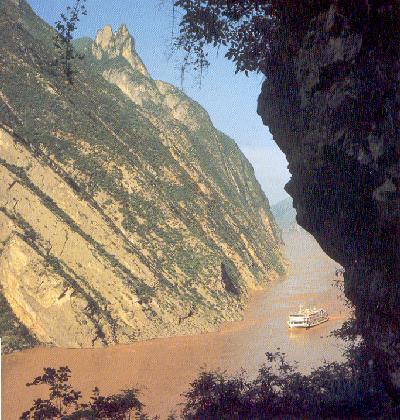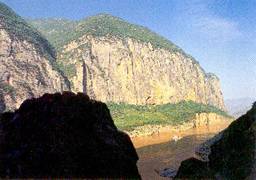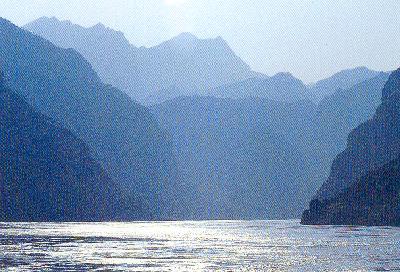Yangtze River
The Yangtze River (Changjiang), over 6,300 kilometers long, is the largest and longest river in China, and the third-longest in the world, next only to the Nile in northeast Africa and the Amazon in South America. The source of the Yangtze River lies to the west of Geladandong Mountain, the principal peak of the Tanggula Mountain chain in the Qinghai-Tibetan Plateau, southwest of China. The river flows from west to east through provinces of Qinghai, Tibet, Sichuan, Yunnan, Sichuan, Hubei, Hunan, Jiangxi, Anhui and Jiangsu as well as the city of Shanghai, finally emptying into the East China Sea. With plenty of rainfall all year round, the Yangtze River is named the golden watercourse.
The most impressive section of the river is the three Yangtze River gorges: Qutang Gorge, Wuxia Gorge and Xiling Gorge, collectively known as Sanxia, or the Three Gorges.
Qutang Gorge
 Qutang Gorge runs eight kilometers from Baidicheng in Fengjie County in the west to Daxizhen in Wushan County, Chongqng City. The shortest among the Three Gorges, it is the most spectacular. As soon as the roaring Yangtze River rushes into the gorge, it meets head-on with the imposing Kuimen Gate. Rocky mountains rise perpendicularly like walls on both sides of the river squeezing the broad river into a narrow ribbon threading its way in the gorge. Here the width of the river is reduced to 100-200 meters and the narrowest places are no more than a few dozen meters while the principal peaks on the banks are as high as 1,000-1,500 meters. The turbulent waters flowing in the deep gorge along a continuous line of peaks make a most magnificent picture.
Qutang Gorge runs eight kilometers from Baidicheng in Fengjie County in the west to Daxizhen in Wushan County, Chongqng City. The shortest among the Three Gorges, it is the most spectacular. As soon as the roaring Yangtze River rushes into the gorge, it meets head-on with the imposing Kuimen Gate. Rocky mountains rise perpendicularly like walls on both sides of the river squeezing the broad river into a narrow ribbon threading its way in the gorge. Here the width of the river is reduced to 100-200 meters and the narrowest places are no more than a few dozen meters while the principal peaks on the banks are as high as 1,000-1,500 meters. The turbulent waters flowing in the deep gorge along a continuous line of peaks make a most magnificent picture.
There are many historical sites in Qutang Gorge. On a hilltop on the north bank are the town of Baidicheng, boasting many rare historical relics. On the south bank are the Whitewashed Wall covered with carved inscriptions, the legendary Meng Liang′s Ladder, the Upside Down Monk, Armour Cave and the sweet-tasting Phoenix-Drinking Fountain in a deep cave. Also on the south bank, not far downstream, is a very strange-looking peak standing by the river; it is called the Rhinoceros Watching the Moon because it looks like a rhinoceros.
Wuxia Gorge
When the river flows out of Qutang Gorge and passes the broad valley of the Daning River, it enters the scenic Wuxia Gorge. Wuxia Gorge is 45 kilometers long, extending west to east from the mouth of the Danning River in Wushan County to Guandukou in Badong County, Hubei Province.
Wuxia Gorge. Wuxia Gorge is 45 kilometers long, extending west to east from the mouth of the Danning River in Wushan County to Guandukou in Badong County, Hubei Province.
Noted for its deep and serene scenes, Wuxia Gorge is full of zigzag, weird peaks, rising mists and beautiful sights. The famous Twelve Peaks on both banks of the river, in particular, are the most spectacular. These strange-looking peaks are like a fairy maid dancing.
Wushan, Badong and Zigui are famous towns in the gorge. There are many famous historic sites too. The town of Zigui is attracting a large number of tourists because it is the native place of the great ancient poet Qu Yuan and the famous beautiful woman Wang Zhaojun.
The Daning River at the western entrance to Wuxia Gorge is flanked by continuous strange peaks, including Longmen, Bawu and Dicui, some of them rising into the clouds and presenting an unusual spectacle. The section of the river becomes known as the Minor Three Gorges.
Xiling Gorge
 The longest among the Yangtze Gorges, Xiling Gorge stretches west to east for 76 kilometers from the mouth of the Xiangxi River at Zigui in Hubei Province to Nanjing Pass near the city of Yichang in Hubei. It is divided into two sections -- the west section consists of the Military Book and Sword Gorge, the Bull′s Liver and Horse′s Lung Gorge and Kongling Play Gorge, while the east section features the Shadow Play Gorge and the Yellow Cat Gorge, otherwise known as Yichang Gorge. Along this gorge sit many archeological sites, including the Huangling Temple, first built during the Three Kingdoms Period (220-280). In addition, the Three Visitors′ Cave and the Luyou Fountain all have their unique features.
The longest among the Yangtze Gorges, Xiling Gorge stretches west to east for 76 kilometers from the mouth of the Xiangxi River at Zigui in Hubei Province to Nanjing Pass near the city of Yichang in Hubei. It is divided into two sections -- the west section consists of the Military Book and Sword Gorge, the Bull′s Liver and Horse′s Lung Gorge and Kongling Play Gorge, while the east section features the Shadow Play Gorge and the Yellow Cat Gorge, otherwise known as Yichang Gorge. Along this gorge sit many archeological sites, including the Huangling Temple, first built during the Three Kingdoms Period (220-280). In addition, the Three Visitors′ Cave and the Luyou Fountain all have their unique features.
Xiling Gorge is known for dangerous rapids and numerous shoals, the latter including the Qingtan, Kongling and Xietan shoals. These shoals were formed out of fallen and rock from banks, boulders and sands washed down from the upper reaches, veins protruding from the riverbanks, or reefs jutting out of the riverbed. At some points there are treacherous whirlpools and the waters are extraordinarily turbulent.
The Yangtze River Valley abounds in natural resources, for instance, mountains like Lingyun, Emei, Qingcheng, Hengshan, Shen Nongjia, Wudang, Lushan, Jinggang, Jiuhua, Huangshan and Mogan, rivers like Minjiang, Jialing, Daning, Qingjiang, Xiangjiang, the Grand Canal, and lakes like Dianchi, Dongting, Honghu, Poyang and Taihu, etc.
Source: http://www.chinaculture.org